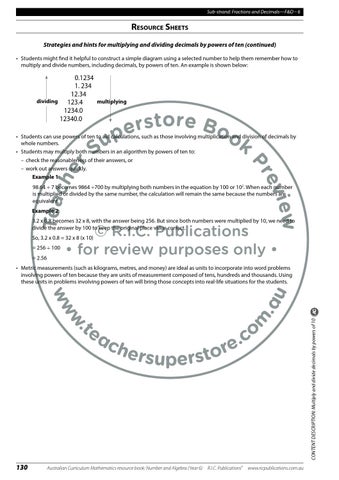Sub-strand: Fractions and Decimals—F&D – 6
RESOURCE SHEETS Strategies and hints for multiplying and dividing decimals by powers of ten (continued) • Students might find it helpful to construct a simple diagram using a selected number to help them remember how to multiply and divide numbers, including decimals, by powers of ten. An example is shown below:
0.1234 1. 234 12.34 dividing multiplying 123.4 1234.0 12340.0
r o e t s Bo r e p ok u S
Teac he r
ew i ev Pr
• Students can use powers of ten to aid calculations, such as those involving multiplication and division of decimals by whole numbers. • Students may multiply both numbers in an algorithm by powers of ten to: – check the reasonableness of their answers, or – work out answers quickly. Example 1: 98.64 ÷ 7 becomes 9864 ÷700 by multiplying both numbers in the equation by 100 or 102. When each number is multiplied or divided by the same number, the calculation will remain the same because the numbers are equivalent. Example 2:
3.2 x 0.8 becomes 32 x 8, with the answer being 256. But since both numbers were multiplied by 10, we need to divide the answer by 100 to keep the original place value correct.
© R. I . C.Publ i cat i ons •f orr evi ew pur posesonl y•
So, 3.2 x 0.8 = 32 x 8 (x 10) = 256 ÷ 100 = 2.56
130
o c . che e r o t r s super
Australian Curriculum Mathematics resource book: Number and Algebra (Year 6)
R.I.C. Publications® www.ricpublications.com.au
CONTENT DESCRIPTION: Multiply and divide decimals by powers of 10
w ww
. te
m . u
• Metric measurements (such as kilograms, metres, and money) are ideal as units to incorporate into word problems involving powers of ten because they are units of measurement composed of tens, hundreds and thousands. Using these units in problems involving powers of ten will bring those concepts into real-life situations for the students.
